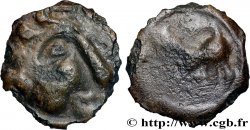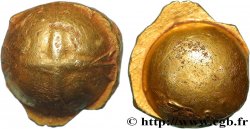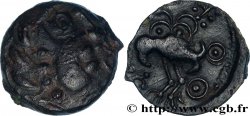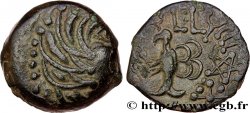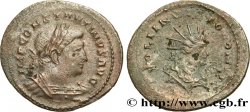v59_0721 - GALLIA - SENONES (Región de Sens) Statère globulaire à la croix, en bronze
MONNAIES 59 (2013)
Precio de inicio : 300.00 €
Valoración : 500.00 €
Precio realizado : 767.00 €
Número de ofertas : 3
Oferta más alta : 850.00 €
Precio de inicio : 300.00 €
Valoración : 500.00 €
Precio realizado : 767.00 €
Número de ofertas : 3
Oferta más alta : 850.00 €
Tipo : Statère globulaire à la croix, en bronze
Fecha: c. 100-80 AC.
Metal: oro
Diámetro: 13 mm
Peso: 4,07 g.
Grado de rareza: R1
Comentarios sobre el estado de conservación:
Très bel exemplaire de ce type en bronze, avec une croix bien nette et une agréable patine verte, avec des zones hétérogènes
N° en los catálogos de referencia :
Anverso
Titulatura del anverso: ANÉPIGRAPHE.
Descripción del anverso: Lisse avec une petite croix en relief.
Reverso
Titulatura del reverso: ANÉPIGRAPHE.
Descripción del reverso: Lisse.
Comentario
Cet exemplaire en bronze est très intéressant. Sans présumer de son aspect dans l’antiquité, bien que l’aspect du bronze puisse ressembler à l’or, il est fort probable qu’il ait du être recouvert d’or pour tromper nos ancêtres ; plus aucune trace n’en subsiste !
Ces statères, d’une typologie très simple, mais d’une technologie complexe, ont malheureusement fait récemment parler d’eux, avec le vol du fameux trésor de Saint-Denis-les-Sens en juin 2012.
D’une simplification extrême, ce statère montre la différence entre notre conception moderne d'une belle monnaie et la conception antique d'une monnaie de valeur ; ce statère de 7,44 grammes d'or valait certainement plus qu'un beau statère des Parisii mais en moins bon or et plus léger ! Il est d’ailleurs intéressant de noter que ce type était représenté aux côtés des 53 statères parisii dans le trésor de Puteaux découvert en 1950. J.-B. Colbert de Beaulieu proposait ces statères globulaires à la croix comme “le premier monnayage d’or des Parisii ?”.
This bronze specimen is very interesting. Without presuming its appearance in antiquity, although the appearance of bronze can resemble gold, it is very likely that it must have been covered in gold to deceive our ancestors; no trace of it remains! These staters, of a very simple typology, but complex technology, have unfortunately recently made headlines, with the theft of the famous treasure of Saint-Denis-les-Sens in June 2012. Extremely simplified, this stater shows the difference between our modern conception of a beautiful coin and the ancient conception of a valuable coin; this stater of 7.44 grams of gold was certainly worth more than a beautiful stater of the Parisii but in less good gold and lighter! It is also interesting to note that this type was represented alongside the 53 Parisii staters in the Puteaux treasure discovered in 1950. J.-B. Colbert de Beaulieu proposed these globular staters with the cross as “the first gold coinage of the Parisii?”
Ces statères, d’une typologie très simple, mais d’une technologie complexe, ont malheureusement fait récemment parler d’eux, avec le vol du fameux trésor de Saint-Denis-les-Sens en juin 2012.
D’une simplification extrême, ce statère montre la différence entre notre conception moderne d'une belle monnaie et la conception antique d'une monnaie de valeur ; ce statère de 7,44 grammes d'or valait certainement plus qu'un beau statère des Parisii mais en moins bon or et plus léger ! Il est d’ailleurs intéressant de noter que ce type était représenté aux côtés des 53 statères parisii dans le trésor de Puteaux découvert en 1950. J.-B. Colbert de Beaulieu proposait ces statères globulaires à la croix comme “le premier monnayage d’or des Parisii ?”.
This bronze specimen is very interesting. Without presuming its appearance in antiquity, although the appearance of bronze can resemble gold, it is very likely that it must have been covered in gold to deceive our ancestors; no trace of it remains! These staters, of a very simple typology, but complex technology, have unfortunately recently made headlines, with the theft of the famous treasure of Saint-Denis-les-Sens in June 2012. Extremely simplified, this stater shows the difference between our modern conception of a beautiful coin and the ancient conception of a valuable coin; this stater of 7.44 grams of gold was certainly worth more than a beautiful stater of the Parisii but in less good gold and lighter! It is also interesting to note that this type was represented alongside the 53 Parisii staters in the Puteaux treasure discovered in 1950. J.-B. Colbert de Beaulieu proposed these globular staters with the cross as “the first gold coinage of the Parisii?”








 Informar de un error
Informar de un error Imprimir la página
Imprimir la página Comparte mi selección
Comparte mi selección Haz una pregunta
Haz una pregunta Consignar / vender
Consignar / vender
 Descriptivo
Descriptivo
